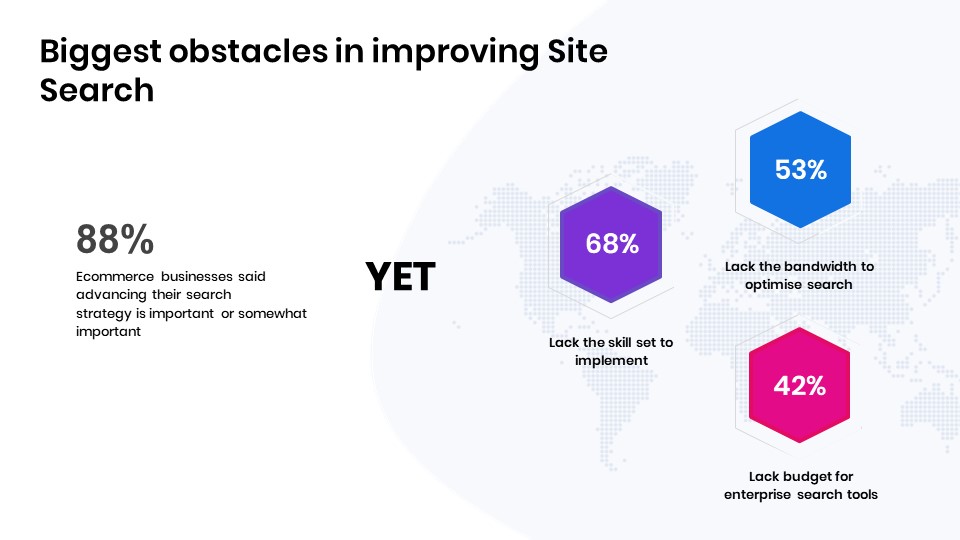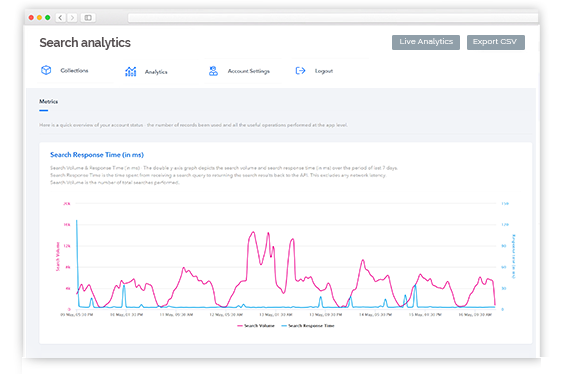eCommerce businesses have seen exponential growth in the last couple of years, thanks to more users on the internet than ever before. Global eCommerce sales are also going to contribute close to $3.5 billion worldwide. In this environment, online retail businesses are trying their best to keep ahead of the competition and continually seeking new ways to improve revenue and conversions.
One feature that has given constant support to online stores is the site search. It has evolved along with the industry and has undergone many changes over the last decade and a half. Now a successful eCommerce search can deliver results and detect typos as they are typed.
The real value, however, for investing in a site search has to be the insights that are gained from the Search Analytics. With this deeper level of understanding into customer behaviour, store owners can make critical decisions relating to product inventory management, new launches, and even new product categories.
Yet despite these vital use-cases, a study by Baynard Institute found that almost 70% of eCommerce site search required users to type the exact terms for products used by the site to get relevant results. 22% of sites didn’t even support queries for colour variation. Looking at this data, it becomes clear that many online stores could use a more lightning-fast and user-friendly search solution.
We did a quick study and found that at least 88% of eCommerce sites said that improving their on-site search was an important task. Surprisingly, they were not able to optimize their search to the desired level due to several reasons. The top 3 among them were:
- 68% of companies lacked the skill-set to implement and manage a high-tech search solution.
- 53% of businesses said that they could not spare the workforce to analyze the search term analytics.
- 42% of stores said that the solutions they were looking at were going to blow their monthly budget.

The challenge then, for many business decision-makers, is to balance the cost and time for implementing the site search. We’ve seen that search customers are typically twice as likely to convert compared to non-search users making eCommerce search optimization a priority.
To make this task more manageable, we’ve made a list of some actionable steps you can use to improve the search experience on your store.
1. Identify Search Patterns
To be able to deliver the ideal search experience for your customers, you need to understand their search pattern. In some cases, visitors on your store are more interested in browsing your products than finding one and will search using broad queries like names of ingredients, occasions, materials, or just specific colour. On the other hand, they can be precise in their query like “blue maxi dress”. Once you have this sort of information, you can make use of these keywords to boost your SEO score by using them to power the content on your website.

2. Mobile Searches
Mobile commerce has been going from strength to strength for some time, and it doesn’t look to be slowing down soon. We’ve seen around 70-80% of traffic and revenue for most of our clients are coming from mobile devices. But this medium has its challenges. Conversion rates tend to be slightly lower than desktop users. The most common reasons being that slow site load speed frustrates users and search has poor typo tolerance. Having a well-implemented search solution becomes vital in this case as it is one of the best ways to keep users engaged on the site.

3. Identify search terms that generate the most revenue
Make sure that you have Enhance eCommerce and Search Analytics enabled on your Google Analytics account for this. Now you will be able to get a better insight into buying decision of visitors on your store and provide valuable input in enhancing website site SEO. Double down on your most popular search terms and use them as categories or even as filters on your search results page.

4. Identify search terms that give no results
Looking at this data is equally as important. You will need to introspect so that you can understand why are people searching for a particular item on your site. Maybe your SEO and marketing efforts are targeting the wrong traffic. There might also be situations many of the zero results appearing despite the products offered. In this case, adding appropriate tags or setting up synonyms can be the way forward. And these could easily lead to new product ideas.

5. Number of search users
You don’t want the time and effort you’ve put into crafting the perfect search for your eCommerce search to go to waste, so check your analytics how many people are using it. If you see low usage for a particular device, then it could mean that visitors are facing a navigational challenge accessing your search. That has a significant negative impact on the search experience on your site. For the best customer experience, the search should be easily accessible across devices.

Conclusion
While it may require considerable effort and planning to refine your site search, the results in improved revenue and engagement make it worthwhile. And it is not only enough to implement an eCommerce search but also to monitor it from time to time to make sure that it is always performing up to the mark.
Continued optimization will go a long way in improving your store’s customer experience, and many small and upcoming eCommerce stores are discovering just that with SearchTap. Here’s how you can find out how we can help you: book a personalized demo or feel free to email us at hello@searchtap.io.



Hi there! Want to ask about something? Leave a message.